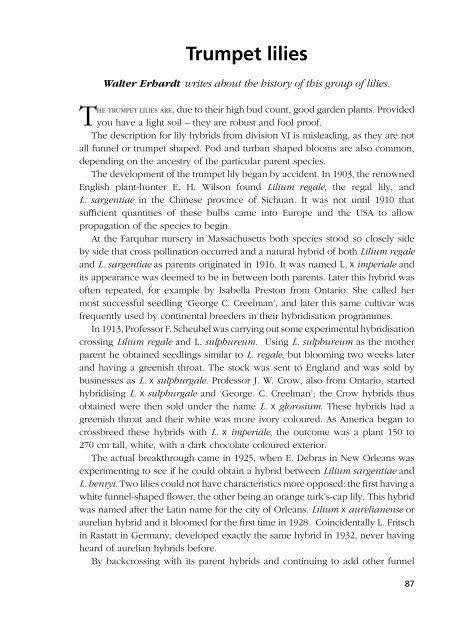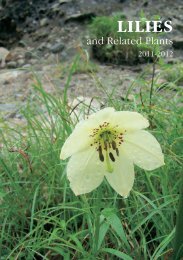LILIES - RHS Lily Group
LILIES - RHS Lily Group
LILIES - RHS Lily Group
Create successful ePaper yourself
Turn your PDF publications into a flip-book with our unique Google optimized e-Paper software.
Trumpet lilies<br />
Walter Erhardt writes about the history of this group of lilies.<br />
HE TRUMPET <strong>LILIES</strong> ARE, due to their high bud count, good garden plants. Provided<br />
Tyou<br />
have a light soil – they are robust and fool proof.<br />
The description for lily hybrids from division VI is misleading, as they are not<br />
all funnel or trumpet shaped. Pod and turban shaped blooms are also common,<br />
depending on the ancestry of the particular parent species.<br />
The development of the trumpet lily began by accident. In 1903, the renowned<br />
English plant-hunter E. H. Wilson found Lilium regale, the regal lily, and<br />
L. sargentiae in the Chinese province of Sichuan. It was not until 1910 that<br />
sufficient quantities of these bulbs came into Europe and the USA to allow<br />
propagation of the species to begin.<br />
At the Farquhar nursery in Massachusetts both species stood so closely side<br />
by side that cross pollination occurred and a natural hybrid of both Lilium regale<br />
and L. sargentiae as parents originated in 1916. It was named L. x imperiale and<br />
its appearance was deemed to be in between both parents. Later this hybrid was<br />
often repeated, for example by Isabella Preston from Ontario. She called her<br />
most successful seedling ‘George C. Creelman’, and later this same cultivar was<br />
frequently used by continental breeders in their hybridisation programmes.<br />
In 1913, Professor F. Scheubel was carrying out some experimental hybridisation<br />
crossing Lilium regale and L. sulphureum. Using L. sulphureum as the mother<br />
parent he obtained seedlings similar to L. regale, but blooming two weeks later<br />
and having a greenish throat. The stock was sent to England and was sold by<br />
businesses as L. x sulphurgale. Professor J. W. Crow, also from Ontario, started<br />
hybridising L. x sulphurgale and ‘George. C. Creelman’; the Crow hybrids thus<br />
obtained were then sold under the name L. x glorosium. These hybrids had a<br />
greenish throat and their white was more ivory coloured. As America began to<br />
crossbreed these hybrids with L. x imperiale, the outcome was a plant 150 to<br />
270 cm tall, white, with a dark chocolate coloured exterior.<br />
The actual breakthrough came in 1925, when E. Debras in New Orleans was<br />
experimenting to see if he could obtain a hybrid between Lilium sargentiae and<br />
L. henryi. Two lilies could not have characteristics more opposed: the first having a<br />
white funnel-shaped flower, the other being an orange turk’s-cap lily. This hybrid<br />
was named after the Latin name for the city of Orleans. Lilium x aurelianense or<br />
aurelian hybrid and it bloomed for the first time in 1928. Coincidentally L. Fritsch<br />
in Rastatt in Germany, developed exactly the same hybrid in 1932, never having<br />
heard of aurelian hybrids before.<br />
By backcrossing with its parent hybrids and continuing to add other funnel<br />
87




